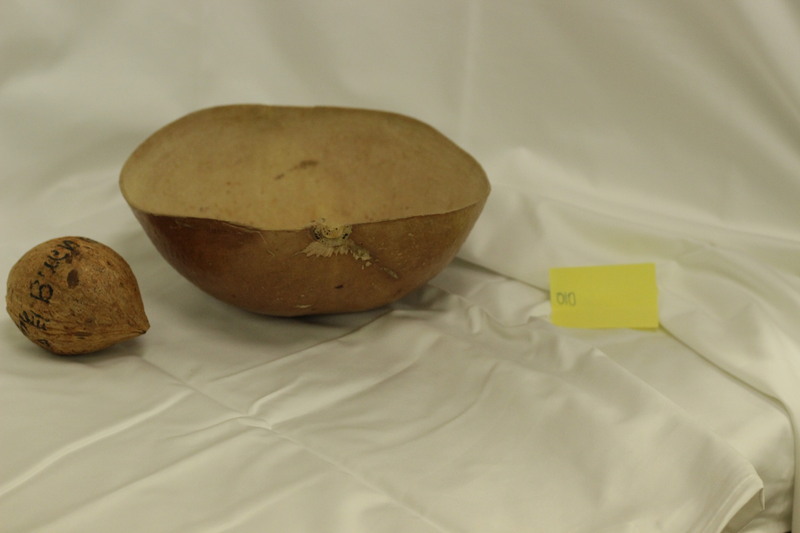Traditional Puerto Rican Dita
Title
Subject
Art, Puerto Rican
Taino Indians—Antiquities
Taino sculpture
Description
At first glance, the Traditional Puerto Rican Dita is merely a bowl made from the dried-out shell of a coconut, yet the symbolism and memories it contains make it much more significant. As with the rest of the Americas, indigenous inhabitants initially populated the island of Puerto Rico. In fact, according to Gabriel Haslip Viera among others, it is a major component of the “semi-official tripartite identity of Spanish, Indian, and African” that was established in Puerto Rico. Accordingly, this bowl serves as a reminder that, in addition to their heritage, Taino cultural practices survived into the twentieth and twenty-first centuries. Nonetheless, some have denied this continued indigenous influence, which one scholar calls “one of the greatest myths ever told in Caribbean history.” As a result, this dita contradicts the idea that Taino practices have vanished from Puerto Rican culture. Additionally, the dita is a practical, affordable vessel for everyday use. As a child, Luz Maria Valles ate out of it, and now she uses it to hold fruit and decorate her home.
Thus, Luz Maria Valles brought it with her to the mainland, she was bringing memories of home along with memories of a culture with which she associates. She is not alone in feeling such a connection; many Puerto Ricans on the island and in the contiguous United States believed that this aspect of Puerto Rican culture should be recognized. For instance, in 1994 Manuel Rodriguez reported that as part of his work for the tourism department of Puerto Rico he made sure to emphasize the role of indigenous cultures. Clearly, the dita represents this broader aspect of Puerto Rican culture, but in the life of Luz Maria Valles it also serves as a memory of home and a point of pride about her heritage. It should be noted that such concepts are important for a group who is often viewed as immigrants when they come to the mainland, even though they are migrating within the borders of the United States.
Historians in the field have frequently discussed Puerto Ricans’ apparently complex relationship with citizenship and nationalism. Ultimately, Jorge Duany argues, “most Puerto Ricans … see no contradiction between asserting their Puerto Rican nationality at the same time that they defend their U.S. citizenship.” It is essentially this sense of belonging to both places that allows for a sense of community when living on the mainland. Valles and other Puerto Ricans in the New Britain area can feel at home with objects that remind them of their culture. At first, this sense of community might have been tepid, but it grew over the course of the latter half of the twentieth century, as greater numbers of Puerto Ricans came to the mainland. For example, in 1970 there were 38,493 individuals identified as Puerto Ricans in Connecticut; by 2000 that number had climbed to 194,443.
Nonetheless, beyond numbers, Puerto Ricans created a strong sense of community due to the very nature of their relationship with the United States. As Virginia Sanchez Korrol points out, in New York City the Puerto Rican community grew in earnest during the first half of the twentieth century after having developed settlements called colonias. Because of the relationship between the United States, Puerto Ricans were able to move more easily than immigrant groups, and thus maintained familial and other relationships both in Puerto Rico and within their mainland community. A similar phenomenon appears to have existed in New Britain. Although this dita does not tell us that the Puerto Rican community in New Britain was as fluid as the one in New York City, it does tell us that some who came to the mainland created and maintained a strong sense of community and cultural pride.
Castanba, Tony. “Adventures in Indigenous Carribean Resistance, Survival and Continuity in Boriken (Puerto Rico).” Wicazo Sa Review 25 2 (Fall 2010): 29 – 64.
Duany, Jorge. “Nation on the Move: The Construction of Cultural Identities in Puerto Rico and the Diaspora.” American Ethnologist 27 (Feb 2000): 5 – 30.
Haslip Viera, ed, Gabriel. Taino Revival: Critical Perspectives on Puerto Rican Identity and Cultural Politics. (New York: Markus Wiener Publications, 2001).
Sanchez Korrol, Virginia. From Colonia to Community: The History of Puerto Ricans in New York City. (Berkley: University of California Press, 1983).
Rodriguez, Manuel. Interview by Thomas Carroll. Patterson, New Jersey. https://www.loc.gov/item/afcwip004015/ .
US Census, 1970: Puerto Ricans in the United States. Washington: US Department of Commerce. 1973.
US Census, 2000: Profiles of General Demographic Characteristics. Washington: US Department of Commerce. 2001.
